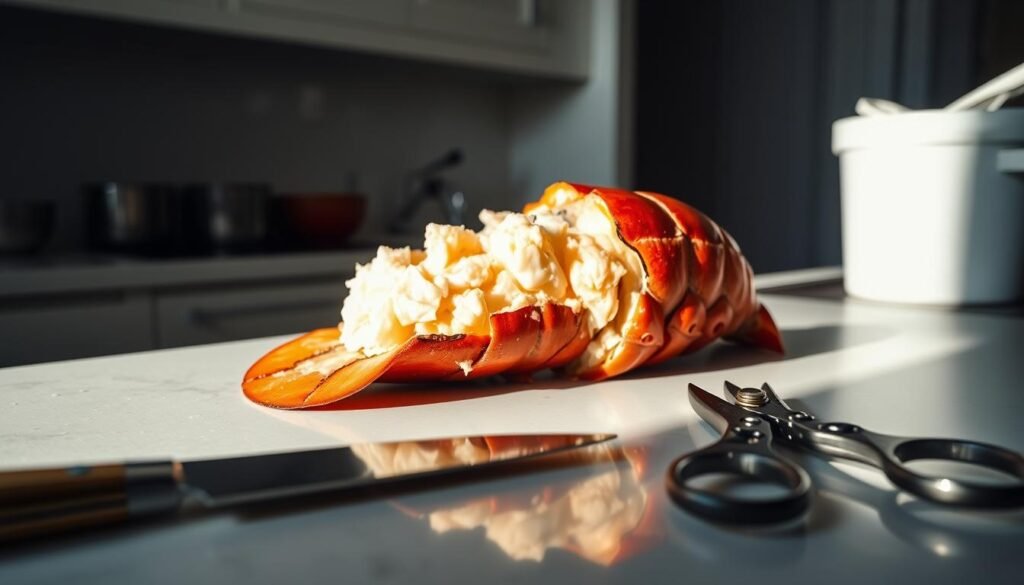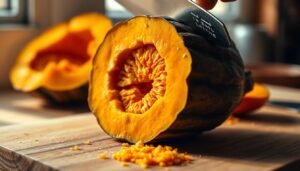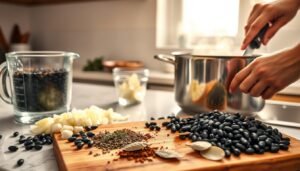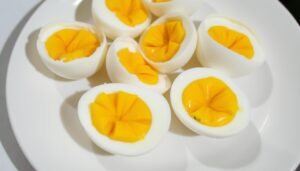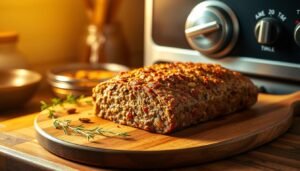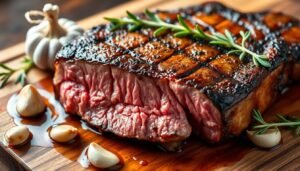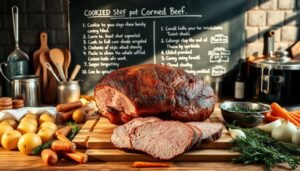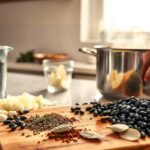Did you know the average American eats over 5.5 pounds of seafood yearly? Lobster is a top choice among seafood lovers. This fact shows seafood’s growing popularity in our diets. It’s key for home cooks to learn how to cook lobster tail.
In this guide, I’ll show you different ways to cook lobster tail. You’ll also find tasty lobster recipes. By the end, you’ll be ready to make restaurant-quality dishes in your kitchen.
Key Takeaways
- Learn to cook lobster tail for a gourmet experience at home.
- Explore various lobster cooking methods for diverse flavors.
- Discover seasonal ingredients that enhance lobster recipes.
- Gain tips for achieving perfectly tender lobster tail.
- Understand essential preparation techniques for beginners.
Understanding Lobster Tails
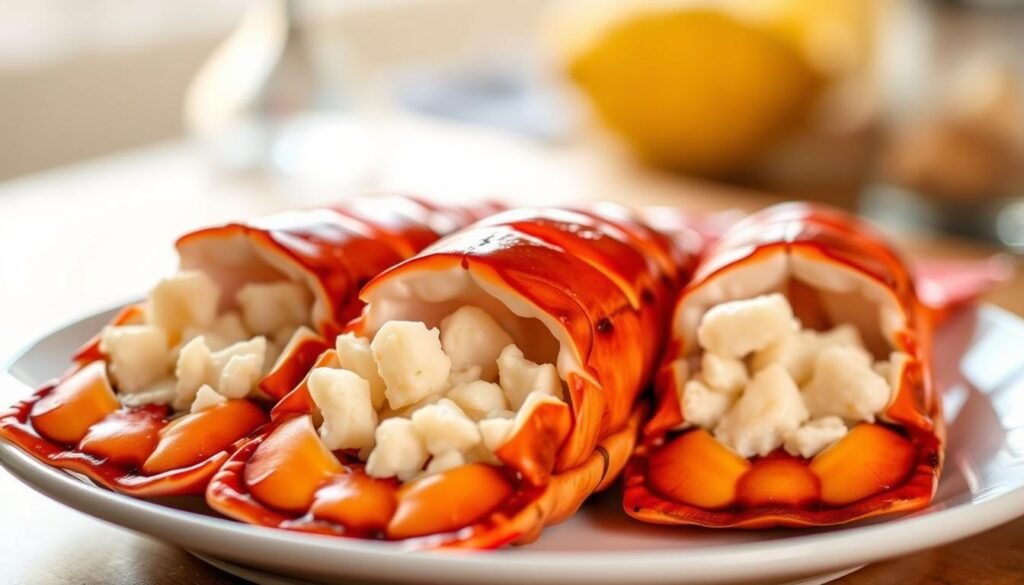
Lobster tails are a favorite among seafood lovers worldwide. They are meaty and loved by chefs and home cooks. Let’s dive into what lobster tails are, the types of lobster, and their nutritional benefits.
What Are Lobster Tails?
Lobster tails are the tender part of a lobster, known for their sweet meat. They come from different lobsters, making them versatile in cooking. A well-cooked lobster tail can make any meal special.
Types of Lobster Tails
There are many types of lobster tails to choose from. They are mainly cold water and warm water lobsters. Cold water lobsters, like Maine lobsters, have firmer meat and stronger flavor. Warm water lobsters, found in warmer places, have a milder taste.
Nutritional Benefits of Lobster
Lobster tails are not just tasty but also healthy. They are high in protein and low in carbs, great for a balanced diet. They also have vitamins A, C, and zinc. Eating lobster can improve your health while enjoying a tasty meal.
Preparing Lobster Tail for Cooking
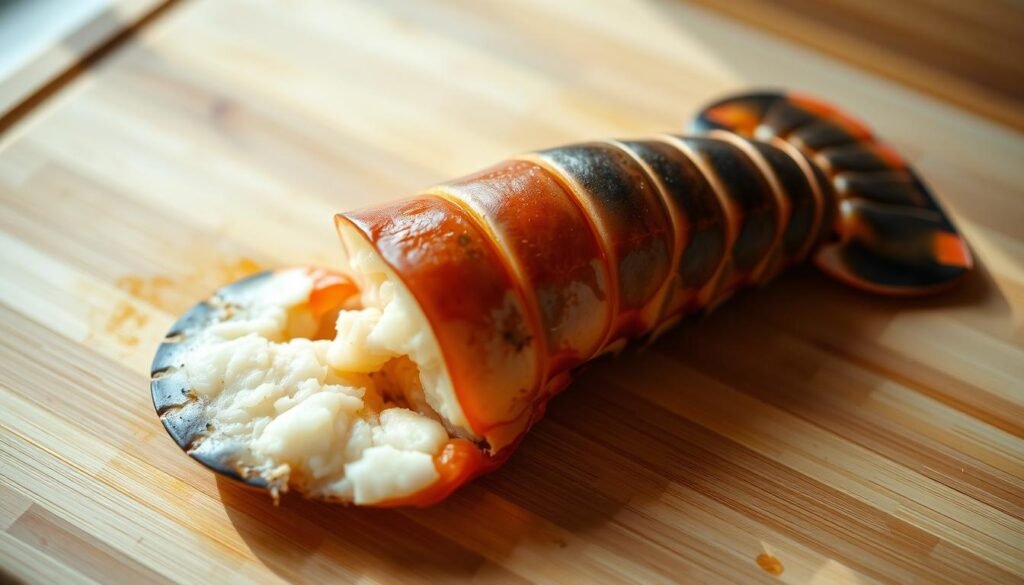
Getting your lobster tail ready is key to a tasty meal. Having the right tools and ingredients makes cooking easier and more fun. Here’s what I suggest for your cooking journey.
Tools and Ingredients Needed
- Kitchen shears: Great for cutting through the lobster shell.
- Baking sheet: Needed for placing the lobster tails while cooking.
- Ingredients: You’ll need lobster tails, butter, garlic, and your favorite seasonings.
How to Properly Thaw Frozen Lobster Tails
There are two good ways to thaw frozen lobster. The first way is to put the tails in the fridge overnight. This slow thaw keeps the meat soft. The second way is faster; just seal the tails in a bag and soak them in cold water for 30 minutes. Both methods work well for cooking.
Essential Safety Tips
Keeping safe in the kitchen is very important when preparing lobster tails. Here are some safety tips to remember:
- Be careful with sharp shells. They can cut you if you’re not careful.
- Make sure all your tools are clean before you start. This prevents contamination.
- Always use stable cutting surfaces when using kitchen shears.
Cooking Methods for Lobster Tail
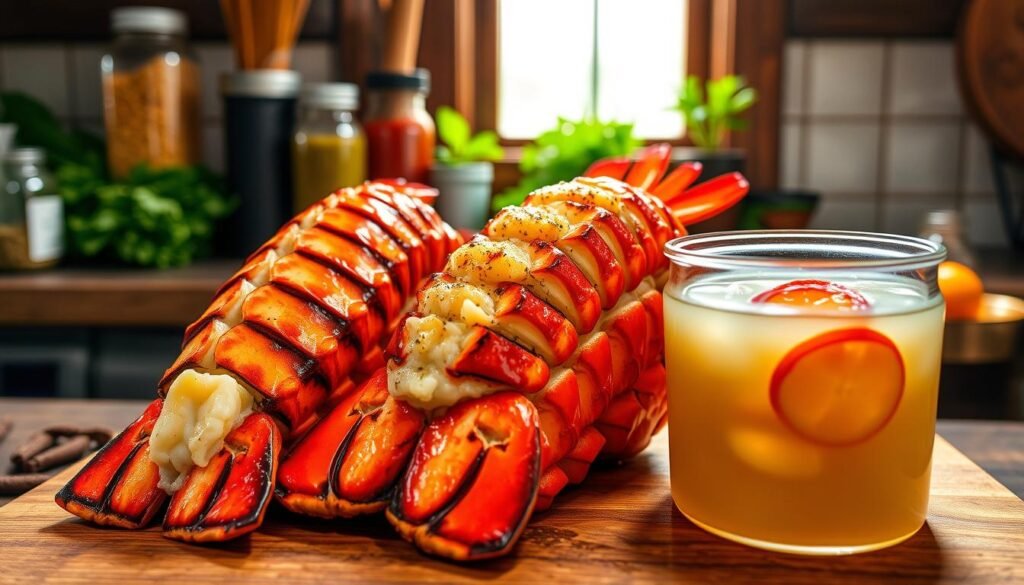
There are many ways to cook lobster tail, each with its own taste and texture. You can boil, steam, or grill lobster for a delicious meal. Let’s dive into these methods.
Boiling Lobster Tail
Boiling is quick and easy. Start by boiling a big pot of salted water. Then, add the lobster tails, making sure they’re covered. Smaller tails cook in 6 to 8 minutes.
They’re done when the meat is white and the shells are bright red. This method keeps the lobster moist and tender.
Steaming Lobster Tail
Steaming helps keep the lobster juicy and flavorful. Fill a steamer with water, put the tails in a basket, and cover. Steam for 10 to 12 minutes, depending on size.
Steaming brings out the lobster’s sweetness and keeps it moist. Just watch it closely to avoid overcooking.
Grilling Lobster Tail
Grilling adds a smoky taste to lobster tail. Preheat the grill and brush the tails with oil and seasonings. Splitting them in half helps them cook evenly.
Grill for 5 to 7 minutes on each side. Keep an eye on them to prevent burning. Grilling gives a crispy outside and tender inside.
How to Bake Lobster Tail
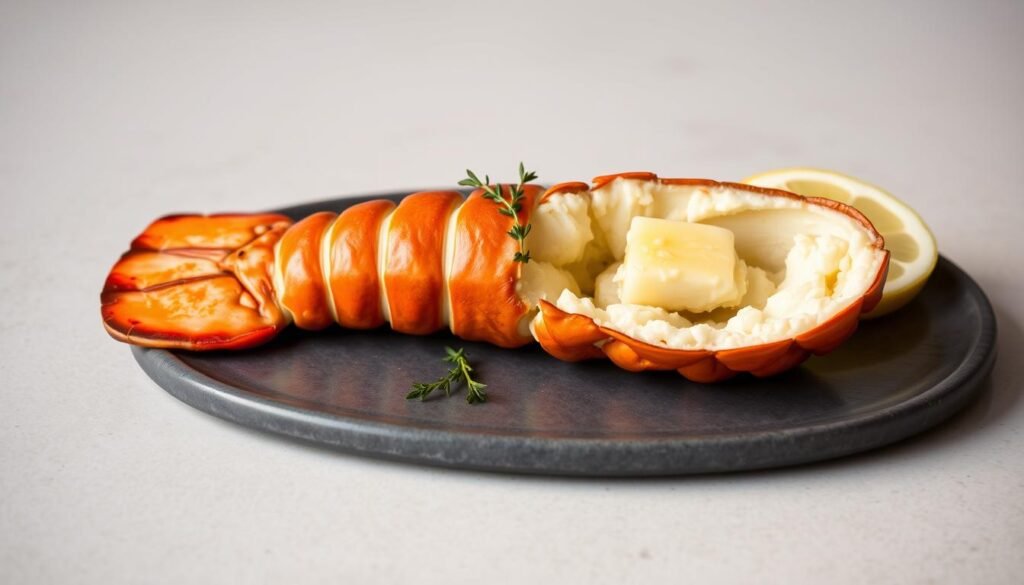
Baking lobster tail is a great way to enjoy this seafood treat. It’s easy to make and tastes amazing with different sides. The secret is using the right baking time and temperature, and choosing the best lobster seasonings.You can learn more about how to cook prime rib .
Baking Temperature and Time
The best baking temperature for lobster tail is 425°F. This ensures it cooks evenly and tastes great. It usually takes 10 to 15 minutes to cook a lobster tail perfectly. The exact time depends on the tail’s size. Always check it’s at least 140°F for safety and flavor.
Recommended Seasonings and Toppings
I like to season my lobster tail with garlic, lemon juice, and paprika. These seasonings boost the flavor without hiding the lobster’s taste. For extra texture, try adding breadcrumbs or fresh herbs on top before baking. It adds a nice crunch and makes it look great.
| Size of Lobster Tail | Baking Time (Minutes) | Internal Temperature (°F) |
|---|---|---|
| 4-5 oz | 10-12 | 140 |
| 6-7 oz | 12-15 | 140 |
| 8-10 oz | 15-18 | 140 |
Broiling Lobster Tail
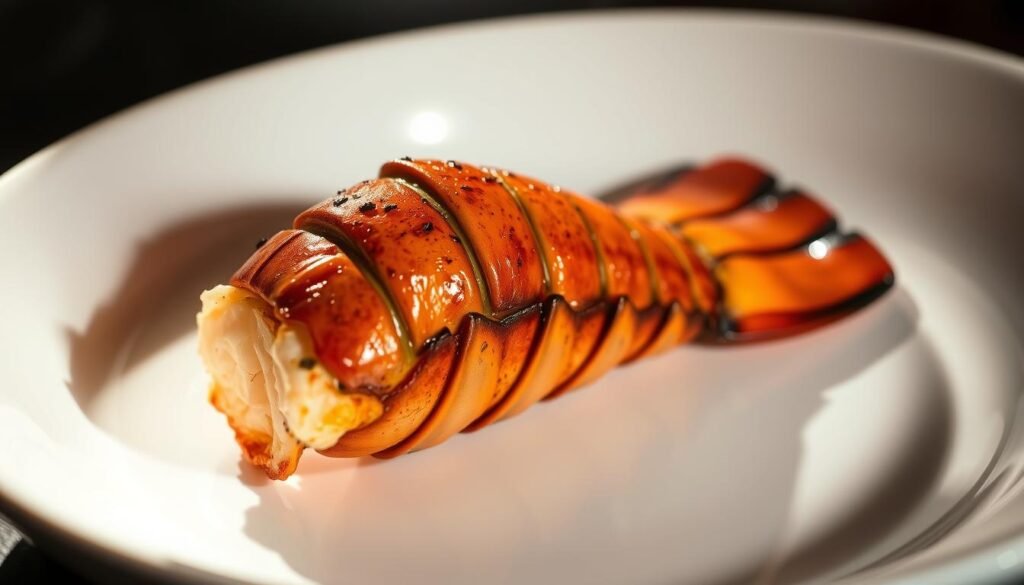
Broiling lobster tail is a great way to keep the flavor and moisture in. By following the right steps, you can make your lobster tail both succulent and tasty. Here’s how to get that perfect broiled lobster.
Step-by-Step Broiling Instructions
- First, preheat your broiler. Put the oven rack about 6 inches from the heat.
- Then, prepare the lobster tails. Use kitchen shears to cut the top shell. Gently pull the shell apart to reveal the meat.
- Brush the lobster meat with melted butter for extra richness.
- Season the lobster with your favorite spices. Garlic powder, paprika, or fresh herbs are great choices.
- Put the lobster tails on a baking sheet. Place them under the broiler.
- Cook for 10-11 minutes. The meat should be opaque and warm inside.
How to Achieve a Perfect Broil
To get a perfect broiled lobster, keep it 6 inches from the broiler. This ensures even cooking without burning. Don’t forget to use plenty of butter. It adds flavor and helps create a golden crust.
While broiling, watch the lobster closely. It should be firm but still tender when done.
Flavoring Your Lobster Tail
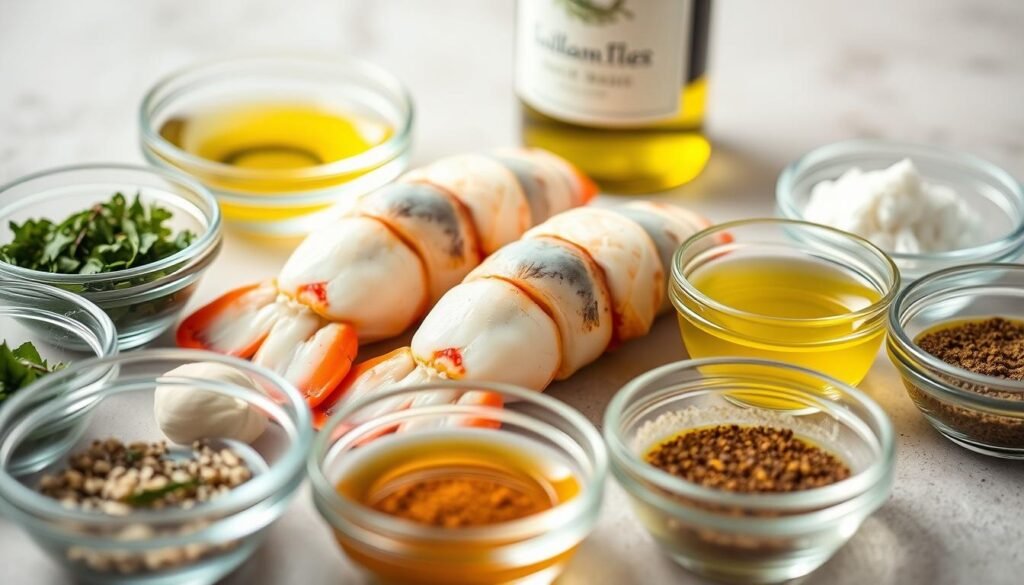
Flavoring lobster tail can make a big difference. The right marinades and sides can really boost the taste. I like to try different marinades to bring out the lobster’s natural sweetness.
Classic mixes like olive oil, garlic, and lemon juice give a fresh taste. Adding a bit of cayenne or smoked paprika adds a fun kick. This makes every bite full of flavor.
Popular Marinades for Lobster Tail
There are many marinades that go well with lobster. Here are a few favorites:
- Olive oil, garlic, lemon juice, and herbs
- Butter with cayenne and smoked paprika
- Citrus-based marinades with soy sauce and ginger
Choosing the right marinade lets you match the lobster to your taste. For more ideas, check out this resource for tasty options.
Butter and Herb Combinations
Butter and herbs can make lobster tail taste amazing. My go-to herb butter recipes include garlic-infused butter. I also love mixes like parsley, chives, and dill.
These combinations add rich flavors and keep the lobster moist. The melting herb butter adds a beautiful shine and a burst of fresh taste.
Using these ideas will make your lobster dish unforgettable. The right mix of flavors can really elevate your cooking.
Serving Suggestions
Serving lobster tail is a delightful experience that makes any meal special. The way you present it and the side dishes you choose are key. I always suggest showing off the lobster’s rich color and texture.
Place it on a bed of fresh greens or with vibrant vegetables. This creates a beautiful contrast that makes the dish hard to resist.You can learn more about how to cook ground beef
How to Plate Lobster Tail
For a fancy look, follow these tips:
- Use a white plate to make the lobster stand out.
- Garnish with lemon wedges and fresh parsley for added flavor and color.
- Position the lobster tail in the center, surrounded by colorful vegetables.
Ideal Side Dishes
Choosing the right side dishes can make the meal even better. Some top picks include:
- Roasted vegetables for a warm, savory contrast.
- Garlic bread that complements the richness of the lobster.
- A light salad to refresh the palate.
For a complete dining experience, try serving lobster tail with lemon butter. This adds flavor and makes the dish even more special. Pairing the lobster with lighter side dishes balances the flavors, making the meal unforgettable.
For more ideas, check out serving lobster tail with lemon butter recipes.
Pairing Wine with Lobster Tail
Finding the perfect wine for lobster tail can make your meal better. The right wine brings out the flavors of the lobster. Think about how the lobster is prepared and seasoned when choosing wine. Here are some top picks.
Recommended Wine Types
For steamed or boiled lobster with drawn butter, try an Albariño from Galicia or an Oregon Pinot Gris. These wines match the lobster’s sweet and buttery flavors. If the lobster is in a creamy sauce, a White Burgundy or a rich California Chardonnay is great.
Chilled lobster in a salad goes well with French Chablis, Sancerre, or a German Riesling. Their acidity cuts through the lobster’s richness. For grilled lobster, a toasty Chardonnay or a versatile Pinot Noir is perfect. A rosé made from Garnacha grapes adds a nice touch.
Stir-fried lobster with Asian seasonings pairs well with a crisp German Riesling or a sparkling wine like Champagne. If the lobster is in a tomato sauce, Chianti or Chianti Classico is a good choice. The right wine makes the lobster taste even better.
Tips for Choosing the Right Wine
Think about how the lobster is prepared when choosing wine. Lighter wines work well with grilled or simply seasoned lobster. But, richer sauces need fuller-bodied wines. Exploring different wines can make your meal even more enjoyable.
For more tips on wine and lobster, check out this resource. Knowing how wine and food work together makes every meal special.
Common Mistakes to Avoid
When cooking lobster tail, it’s important to avoid common mistakes. These errors can make the dish disappointing, like overcooking lobster. The right timing and technique are key to tender, flavorful meat.
Overcooking Lobster Tail
Overcooking lobster makes it tough and rubbery. To avoid this, watch the cooking time closely. It usually takes 8 to 10 minutes for the first pound, with 2 to 3 minutes extra for each pound after. Using a thermometer to check for 140°F internal temperature helps a lot.
Using Inadequate Seasoning
Not using enough seasoning is another mistake. The right seasoning tips can make the lobster taste even better. I mix salt and herbs that complement the lobster without overpowering it. For great seasoning ideas, check out this resource.
Storing Leftover Lobster Tail
Knowing how to store lobster leftovers is key. It keeps the meat safe and lets me enjoy it later. If I have leftover lobster tail, I follow important storage tips.
How to Properly Store Lobster
To store lobster tail, I put it in an airtight container in the fridge. It’s best to eat it within 2 days for freshness. If I need to keep it longer, freezing is a good choice.
For freezing, I soak the meat in milk, then drain it. Then, I put it in a plastic bag, removing air to freeze for up to 3 months. For tasty lobster recipes, I check out these ideas.
Reheating Techniques
Reheating lobster needs care to keep its flavor and texture. My top method is using the oven. I wrap the tail in foil with butter to stay moist.
Setting the oven to 350°F, I heat it for about 10 minutes. This method ensures a moist and flavorful lobster meal, even after storing.
Conclusion
Cooking lobster tails at home is easy if you’re willing to try. We’ve talked about boiling, baking, and grilling. Each method brings out different flavors and textures, making your meal special.
Why cook lobster? It’s not just about the taste. It’s also about enjoying the cooking process. You can try simple sauces or bold marinades. It’s a great way to improve your cooking skills.
Creating a delicious lobster dish is very rewarding. So, go ahead and try cooking lobster. Impress your family and friends with your new skills. For more cooking tips, check out this guide: cooking lobster tails at home.


